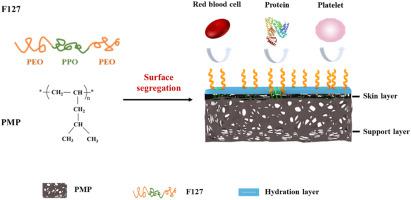Journal of Membrane Science ( IF 8.4 ) Pub Date : 2023-04-26 , DOI: 10.1016/j.memsci.2023.121695 Yuhang Guo , Liping Shao , Runnan Zhang , Wenqing Gao , Shiyao Yu , Yuqian Du , Guangzhaoyao Yang , Fusheng Pan , Tong Li , Zhongyi Jiang

|
Oxygenation membranes in extracorporeal membrane oxygenation (ECMO) with excellent gas permeability, good hemocompatibility and durable resistance to plasma leakage is the key to achieve long-term and efficient blood oxygenation. This study put forward surface segregation strategy in thermally induced phase separation (TIPS) of poly(4-methyl-1-pentene) (PMP) membranes to realize the in-situ surface modification. Heterostructured PMP membranes with hydrophilic hemocompatible surface and hydrophobic body were obtained by migration of hydrophilic segments of the amphiphilic block copolymer Pluronic F127 to the surface in their preparation process. The hydrophilic surface could effectively improve hemocompatibility of membranes through hydration layer effect and steric hindrance effect, also reduce platelet adhesion significantly, and prolong the coagulation time of the four coagulation items within the normal physiological range of human body. When adding 10 wt% F127, the membrane exhibited an optimum CO2 permeance of ∼11461 GPU and O2 permeance of ∼13335 GPU, respectively, and an optimized blood oxygenation performance in vitro with O2 flux of 122.9 ml min−1 m−2 and CO2 flux of 129.2 ml min−1 m−2, and the asymmetric structure ensures resistance to plasma leakage for more than two months, that showed great application potential. Besides, preparation of hollow fiber membranes based on surface segregation was also explored, aiming to realize the enhanced performance and large-scale preparation of PMP oxygenation membranes. The membranes prepared in this work exhibited an outstanding performance when applied in blood oxygenation, showing great application potentials.
中文翻译:

用于血液氧合的表面分离改性聚(4-甲基-1-戊烯)膜
体外膜肺氧合(ECMO)中的氧合膜具有优异的透气性、良好的血液相容性和持久的抗血浆渗漏能力,是实现长期高效血液氧合的关键。本研究提出了聚(4-甲基-1-戊烯)(PMP)膜热诱导相分离(TIPS)中的表面分离策略,以实现原位表面改性。具有亲水性血液相容表面和疏水体的异质结构 PMP 膜是通过在其制备过程中将两亲性嵌段共聚物 Pluronic F127 的亲水性部分迁移到表面而获得的。亲水表面可通过水化层效应和位阻效应有效改善膜的血液相容性,显着降低血小板粘附,延长人体正常生理范围内四种凝血项目的凝血时间。当添加 10 wt% F127 时,膜的最佳 CO 2渗透率分别为 ~ 11461 GPU 和 O 2渗透率 ~ 13335 GPU,以及优化的 O 2体外血氧性能122.9 ml min -1 m -2的通量和129.2 ml min -1 m -2的CO 2通量,非对称结构确保了两个多月的抗等离子体泄漏,显示出巨大的应用潜力。此外,还探索了基于表面偏聚的中空纤维膜制备,旨在实现PMP增氧膜的性能提升和规模化制备。本工作制备的膜在血液氧合中表现出优异的性能,显示出巨大的应用潜力。


















































 京公网安备 11010802027423号
京公网安备 11010802027423号